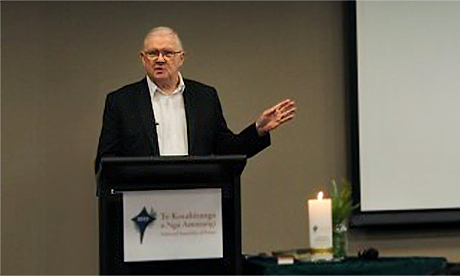Diocesan priests assembled last week in Rotorua were told they should think laterally and reach out in new and imaginative ways like they have never done before.
Speaking for a second time to the Assembly, Brisbane’s Archbishop Mark Coleridge reflected on the experience in Australia and asked what the Church is learning.
“This is the time for a new surge in gospel energy,” he said.
Imagination is part of evangelisation
Societal change is affecting the Church and there’s nothing new in that, Coleridge commented.
However, it is a matter of how we approach this change, how we use this change and work with it that matters, he said.
“We have to have the courage to say farewell to that which has served us so well.”
Coleridge said change will come from below from those most involved in the new situation, which isn’t surprising.
“Lay people may lead this new surge, not the priests, not the monks, surprise surprise.
“We have to move from maintenance to mission.”
Right now, we have too many churches, too many Masses and too many parishes.
The current model of Church in Australia and New Zealand is built on foundations that worked in the past. That model isn’t sustainable, Coleridge told the Assembly.
“The Church and parishes were built on the assumption that most Catholics would come to Mass. But now they don’t,” Coleridge pointed out,” he explained.
“We still have structures based on those other times.”
Take a risk
Considering the facts in front of us today, Coleridge’s suggestion for the diocesan priests to think laterally took shape.
He suggested showing a bit of apostolic integrity and taking some risks.
He realises many people hate change – but it has to happen, he said.
When it happens, the Church must include explanations that show everyone the reasons for decisions.
“In towns and cities, we are talking about ‘communities of communities’ where each community is respected but drawn into a larger community.”
Coleridge said the prime goal is to generate new possibilities for mission – and Pope Francis is showing us the way forward.
The Papal court protocols imprisoned Pope Benedict, but Francis is breaking free from them. He, in turn, is showing us how to break free, he told the Assembly.
Moving towards a community of communities type model will require another leadership model because the current model is not sustainable. Coleridge said.
Changing times
The former abundance of clergy doesn’t exist today, Coleridge noted.
As a Church with sacraments, we must have priests and bishops.The priesthood could be re-situated, however, taking its place in a leadership team, he suggested.
That would suggest moving from a hierarchical to a charismatic leadership model, although not all priests have that charism, he noted.
Lleaders may need to come from elsewhere, he suggested.
By way of an example, he said the community of communities’ model leadership team might include lay people, a deacon, or a consecrated religious.
The new approach will need training and proper preparation, but it is vital to consider these times and think laterally as we do.
Source
